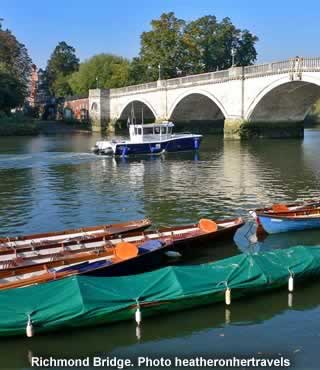Richmond upon Thames |
|
 |
|||
An elegant town on the outskirts of London with a Royal history |
Before the 16th century, this area to the west of London was called Shene. But in 1501, King Henry VII built Richmond Palace here, on the banks of the Thames. A town began to grow around this new royal residence, which also took the name of Richmond. In time, the entire borough began to borrow the name of Henry's palace, and so today, Richmond town is officially part of the London Borough of Richmond upon Thames. |
Very little of Richmond Palace is still standing. Parts of the structure were incorporated into new residential houses, giving some of Richmond an elegant Tudor look. Nearby, you can find Richmond Green. This wide expanse of grass was once used for royal tournaments and jousts, but nowadays you're more likely to find it full of cricketers! |
Richmond is also home to an even better open space, which is the largest of London's royal parks. It's arguably the best area of greenery and park life in the capital, and is home to several hundred wild deer. This is Richmond Park, which was originally used by the monarchy as a hunting ground. It's now a Site of Special Scientific Interest, and a National Nature Reserve, full of interesting plants and creatures. There's plenty to explore, from old listed buildings, to woodland gardens. You shouldn't leave without enjoying the protected view from the top of King Henry VIII's mound, which is the tallest part of the park. From here, you can see St. Paul's Cathedral, and many of central London's other major landmarks. |
The town of Richmond itself is on the Thames, a fact that makes up an important part of its identity. Richmond Bridge, which dates from the 18th century, is the oldest Thames crossing in the whole of Greater London. It's made up of 5 graceful stone arches, and is a Grade-I listed structure. |
Many of Richmond's most interesting sights are also on the riverside. There's Marble Hill House, which was built for King George II's mistress. She was a very sociable woman who hosted all sorts of fashionable parties. The house's carefully recreated interior gives a perfect impression of what life must have been like for the crme-de-la-crme of Georgian society. |
Directly across the river from here is Ham House, an even older 17th-century building with a finely furnished, art-filled interior. It has survived unusually well since its construction, and has actually barely changed at all since then. It's supposedly one of the most haunted houses in all of London. |
A short distance downstream is the Orleans House Gallery, which was converted into an art museum from an 18th-century house. It hosts both historic and contemporary exhibits, and is the borough's primary art space. Places like this make riverside walks one of Richmond's very best activities. |
The town itself though, is also definitely worth a look. It's devoid of huge shopping centres, and instead focuses on smaller shops, including many famous designers. There are pleasant narrow alleyways, which are interesting to explore. Richmond Theatre, right in the centre of town, hosts major touring shows, as well as some previews of West End plays. |
Outside of town, the borough of Richmond upon Thames hosts some of the capital's very best sights, like Hampton Court, the former palace of Henry VIII, and Kew Gardens, possibly the world's most famous garden. |
|
Pocket Britain is optimised for use on a smartphone or tablet with internet access. All content is subject to copyright. All reasonable methods have been used to ensure information supplied is accurate at the time of publication. However, it is advisable to check information before relying on it. Privacy Policy |